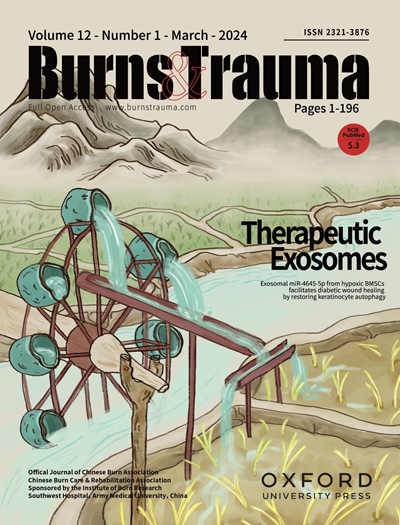单细胞RNA测序揭示了糖尿病足溃疡的表皮分化和病理微环境受损
IF 9.6
1区 医学
Q1 DERMATOLOGY
引用次数: 0
摘要
糖尿病足溃疡(DFU)是糖尿病最常见和最复杂的并发症之一,但其病理生理机制尚不清楚。单细胞RNA测序(scRNA-seq)已被用于从不同角度探索DFU的新细胞类型或分子谱。本研究旨在从单细胞角度全面分析DFU再上皮受损的潜在机制。方法对人体正常皮肤(NS)、急性伤口(AW)和DFU组织进行scrna测序,探讨表皮分化受损的潜在机制和病理微环境。伪时间和谱系推断分析揭示了不同条件下表皮细胞的不同状态和转变轨迹。转录因子分析揭示了角化细胞关键亚型的潜在调控机制。细胞间相互作用分析揭示了促炎微环境与表皮细胞之间的调节网络。使用激光捕获显微镜结合RNA测序(LCM-seq)和多重免疫组织化学(mIHC)来验证角化细胞关键亚型的表达和定位。我们的研究提供了表皮分化过程中发生的表型和动态变化的综合图谱,以及DFU中相应的调节网络。重要的是,我们确定了两种角化细胞亚型:基底细胞(BC-2)和糖尿病相关角化细胞(DAK),它们可能在表皮稳态损害中起关键作用。BC-2和DAK的DFU明显升高,处于失活状态,表皮分化动力不足。BC-2参与细胞应答和凋亡过程,高表达TXNIP、IFITM1和IL1R2。此外,DFU中BC-2的促分化转录因子(pro-differentiation transcription factors, TFs)下调,表明DFU中BC-2的分化过程可能受到抑制。DAK与细胞葡萄糖稳态有关。此外,DFU中CCL2 + CXCL2+成纤维细胞、VWA1+血管内皮细胞和GZMA+CD8+ T细胞增加。这些伤口微环境的变化可能通过TNFSF12-TNFRSF12A、IFNG-IFNGR1/2和IL-1B-IL1R2通路调控表皮细胞的命运,从而导致DFU持续炎症和表皮分化受损。我们的研究结果为DFU的病理生理学提供了新的见解,并提出了潜在的治疗靶点,可以改善糖尿病患者的伤口护理和治疗效果。本文章由计算机程序翻译,如有差异,请以英文原文为准。
Single-cell RNA sequencing reveals the impaired epidermal differentiation and pathological microenvironment in diabetic foot ulcer
Background Diabetic foot ulcer (DFU) is one of the most common and complex complications of diabetes, but the underlying pathophysiology remains unclear. Single-cell RNA sequencing (scRNA-seq) has been conducted to explore novel cell types or molecular profiles of DFU from various perspectives. This study aimed to comprehensively analyse the potential mechanisms underlying impaired reepithelization of DFU in a single-cell perspective. Methods We conducted scRNA-seq on tissues from human normal skin (NS), acute wound (AW) and DFU to investigate the potential mechanisms underlying impaired epidermal differentiation and the pathological microenvironment. Pseudo-time and lineage inference analyses revealed the distinct states and transition trajectories of epidermal cells under different conditions. Transcription factor analysis revealed the potential regulatory mechanism of key subtypes of keratinocytes. Cell–cell interaction analysis revealed the regulatory network between the proinflammatory microenvironment and epidermal cells. Laser-capture microscopy coupled with RNA sequencing (LCM-seq) and multiplex immunohistochemistry (mIHC) were used to validate the expression and location of key subtypes of keratinocytes. Results Our research provided a comprehensive map of the phenotypic and dynamic changes that occur during epidermal differentiation, alongside the corresponding regulatory networks in DFU. Importantly, we identified two subtypes of keratinocytes: basal cells (BC-2) and diabetes-associated keratinocytes (DAK) that might play crucial roles in the impairment of epidermal homeostasis. BC-2 and DAK showed a marked increase in DFU, with an inactive state and insufficient motivation for epidermal differentiation. BC-2 was involved in the cellular response and apoptosis processes, with high expression of TXNIP, IFITM1 and IL1R2. Additionally, the pro-differentiation transcription factors (TFs) were downregulated in BC-2 in DFU, indicating that the differentiation process might be inhibited in BC-2 in DFU. DAK was associated with cellular glucose homeostasis. Furthermore, increased CCL2 + CXCL2+ fibroblasts, VWA1+ vascular endothelial cells and GZMA+CD8+ T cells were detected in DFU. These changes in the wound microenvironment could regulate the fate of epidermal cells through the TNFSF12-TNFRSF12A, IFNG-IFNGR1/2 and IL-1B-IL1R2 pathways, which might result in persistent inflammation and impaired epidermal differentiation in DFU. Conclusions Our findings offer novel insights into the pathophysiology of DFU and present potential therapeutic targets that could improve wound care and treatment outcomes for diabetic patients.
求助全文
通过发布文献求助,成功后即可免费获取论文全文。
去求助
来源期刊

Burns & Trauma
医学-皮肤病学
CiteScore
8.40
自引率
9.40%
发文量
186
审稿时长
6 weeks
期刊介绍:
The first open access journal in the field of burns and trauma injury in the Asia-Pacific region, Burns & Trauma publishes the latest developments in basic, clinical and translational research in the field. With a special focus on prevention, clinical treatment and basic research, the journal welcomes submissions in various aspects of biomaterials, tissue engineering, stem cells, critical care, immunobiology, skin transplantation, and the prevention and regeneration of burns and trauma injuries. With an expert Editorial Board and a team of dedicated scientific editors, the journal enjoys a large readership and is supported by Southwest Hospital, which covers authors'' article processing charges.
 求助内容:
求助内容: 应助结果提醒方式:
应助结果提醒方式:


